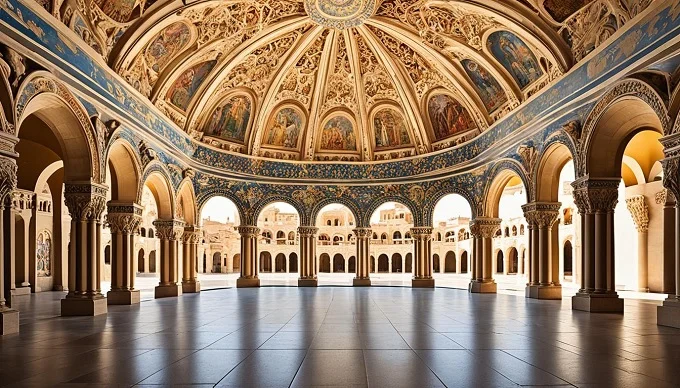
Ever wondered about the amazing parts of Ottonian-era buildings? The Arcade in Ottonian Architecture is key to their beauty. It’s a series of arches held up by columns or piers. These arches were a big part of the medieval style.
In Ottonian architecture, arcades were everywhere. They were in cathedrals and monasteries, adding beauty and purpose. But what made them so important? Let’s dive into the world of Arcade in Ottonian Architecture and see why they mattered so much.
Unveiling the Essence of Arcade in Ottonian Architecture
The Arcade in Ottonian Architecture was key in the Ottonian dynasty’s architecture, from the 10th to the 11th centuries. It added rhythm and harmony to buildings. It also let in natural light, connecting people with the divine.
Defining the Arcade in Ottonian Architecture’s Role in Medieval Architecture
The Arcade in Ottonian Architecture was more than just for looks in Ottonian architecture. It was vital to the building’s design, adding beauty and mood. Made of arches supported by columns, it created a captivating pattern.
The Artistic and Functional Significance of Arches
The arches in the Arcade in Ottonian Architecture were not just for support. They showed the Ottonian dynasty’s skill and care. With clerestory windows, they let in light, making the inside peaceful and inspiring.
Understanding the Arcade in Ottonian Architecture’s role in Ottonian architecture is key. It improved the look and function of buildings. Remember terms like “arch arcade,” “gero,” and “clerestory” to learn more about this architectural wonder.
“The Arcade in Ottonian Architecture was an important element that allowed natural light to enter the sacred spaces, fostering a connection between the worshippers and the divine.”
What is the Arcade in Ottonian Architecture
The Arcade in Ottonian Architecture was a key part of Ottonian architecture. It was a series of arched openings held up by columns or piers. These were often in a repeating pattern. You could see them a lot in churches, monasteries, and other religious places from the 10th to the 11th centuries.
Architects of the time used Arcade in Ottonian Architecture a lot. They were usually in the courtyard or around the cathedral’s outside. These walkways, held up by columns, made the building look grand. They also made people focus on the building’s holy purpose.
The Arcade in Ottonian Architecture was more than just for looks. In churches, it gave people covered paths to walk on. This kept them dry and safe from the weather. It made the church feel like a special place, setting apart the spiritual world inside from the outside.
Architects of the Ottonian period showed great skill with the Arcade in Ottonian Architecture. They used arches and columns together to make a design that was both beautiful and useful. This design helped the building look great and met the needs of those who came to worship.
Exploring the Different Types of Arcades
Ottonian architecture featured two main types of arcades: blind and open ones. These elements were key in adding visual interest and functional connections to medieval buildings.
Blind Arcades: Enhancing Visual Appeal
Blind arcades added depth and texture to buildings without being passageways. They made the building look more interesting and caught the eye. Often found in chapels and other parts of buildings, they made a big visual impact.
Open Arcades: Connecting Spaces with Grace
Open arcades were used to link different parts of a building. They let in natural light and sound, making the space more inviting. The use of piers and columns added beauty and depth, connecting building parts smoothly.
The placement of arcades was a key part of Ottonian architecture. It showed the importance of design and function in medieval times. Arcades made buildings more visually appealing and added depth and texture.
Crafting Sacred Spaces: Arcades in Religious Buildings
In Ottonian religious buildings, the arcade was key in making sacred spaces. These spaces felt reverent and connected to the divine. The light that came through the arches made the space bright and beautiful.
Ottonian architects loved intricately carved arcades in their designs. They showed how important this feature was. The archways with geometric patterns made the inside look stunning. They added depth and made the space feel grand.
Arcades in Ottonian religious buildings were not just for looks. They let in natural light, showing off the intricate carvings and symbols of power. This mix of light and design made people feel awe and respect.
“The arcade was a common feature in Ottonian religious structures, often placed as a symbol of power and to emphasize the importance of the building within the community.”
Ottonian builders used arcades to make beautiful and sacred spaces. They knew the arcade could connect people with the divine. The carvings and light and shadow made the arcade a key part of their sacred spaces.
Conclusion
The Arcade in Ottonian Architecture was a key part of Ottonian architecture. It added to the building’s rhythm, harmony, and sacred feel. The blind arcades brought depth and visual interest. The open arcades connected different areas, playing a big role in Ottonian design and craftsmanship.
Understanding the Arcade in Ottonian Architecture helps us appreciate Ottonian architecture and medieval European art more. The arcade managed light and shadow, making spaces feel open and airy. It also played a big part in the design of churches and other religious buildings.
Whether you like the light and shadow effects or the inviting atmosphere, the Arcade in Ottonian Architecture is a key part of medieval architecture. It still inspires and fascinates people who love architecture and history.
